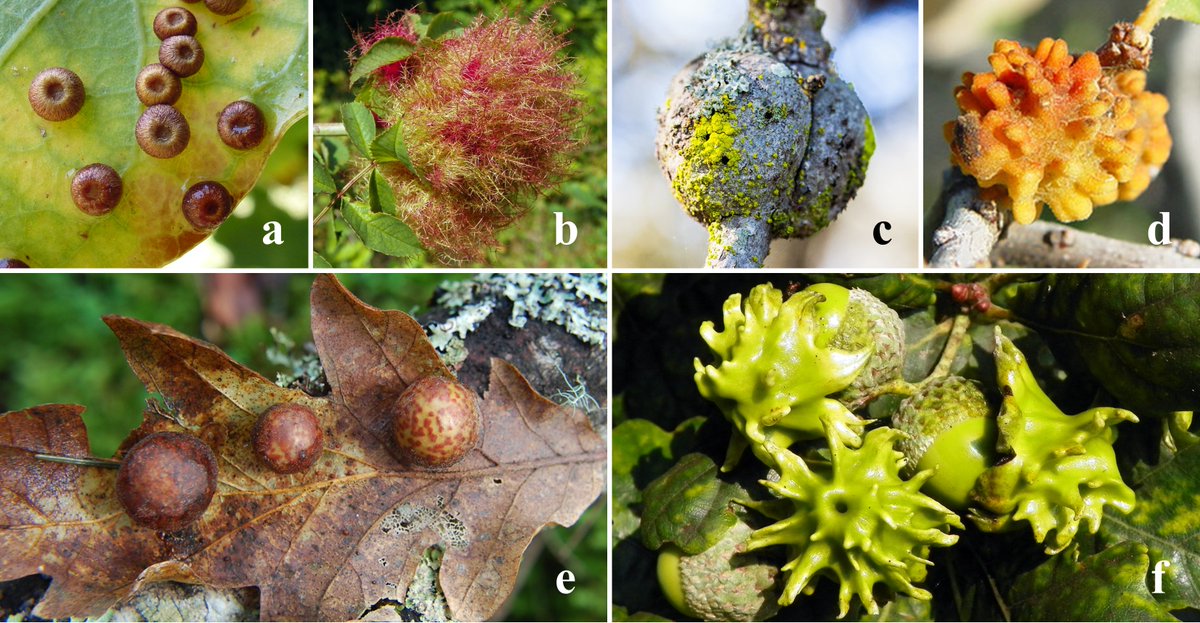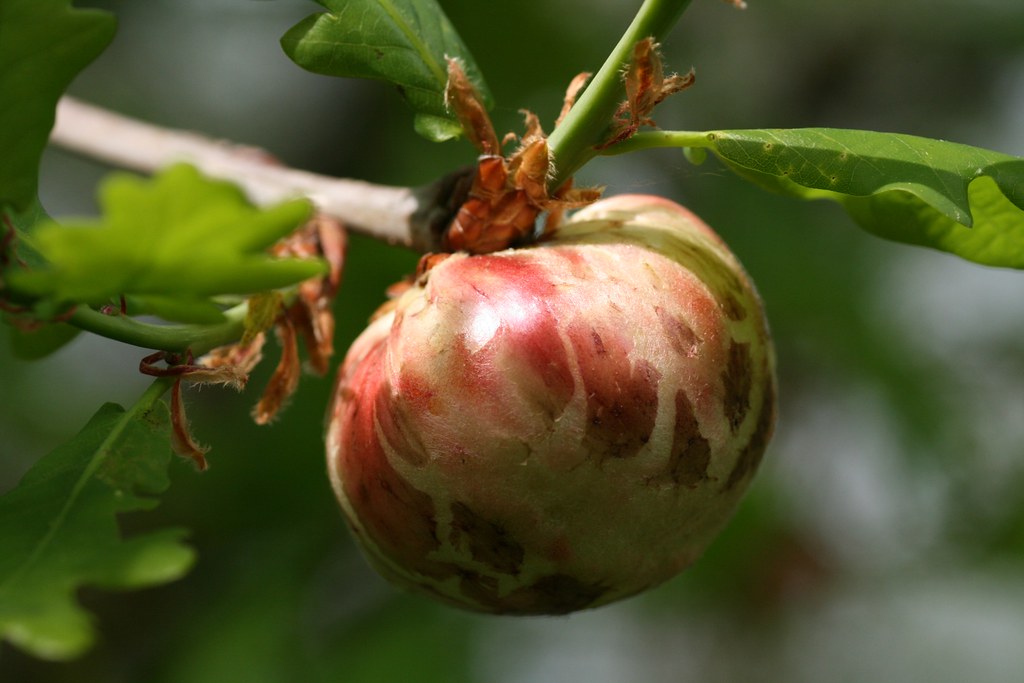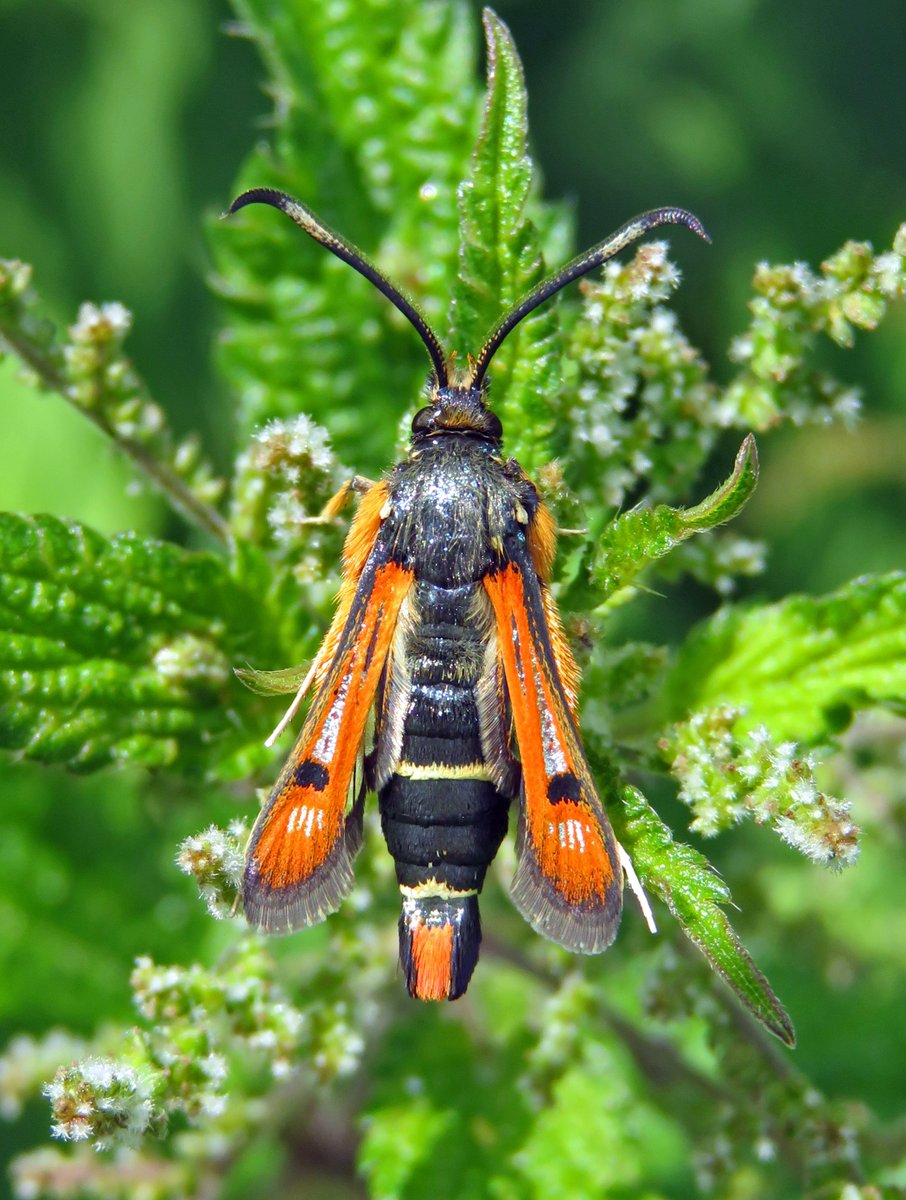
It's Friday, and that means… an entomological #thread 🧵!
You've probably seen structures like the ones in the image below growing on trees. Do you know that some are induced by insects? Let's talk about galls: a small ecosystem ⬇️
📸Andricus kollari galls (Jamie McMillan)
You've probably seen structures like the ones in the image below growing on trees. Do you know that some are induced by insects? Let's talk about galls: a small ecosystem ⬇️
📸Andricus kollari galls (Jamie McMillan)

Galls are abnormal outgrowths of different plant tisues or organs 🌿 that undergo 3 processes:
- Hypertrophy: abnormal growth
- Hyperplasy: abnormal cell multplication
- Neogenesis: development of new tissue
This causes tissues and organs to grow.
- Hypertrophy: abnormal growth
- Hyperplasy: abnormal cell multplication
- Neogenesis: development of new tissue
This causes tissues and organs to grow.
Galls can be triggered by viruses, fungi 🍄, bacteria 🦠, other plants 🌿, mites 🕷️, and insects 🐝. The most common are those induced by insects and among them, those caused by hymenopterans (gall wasps) are the most visually striking and structurally complex. 

Gall wasps (Fam. Cynipidae) are mainly distributed throughout the Northern Hemisphere. They're small (barely a few mm) and develop as parasites of different plants, specifically as specialized endophytophagous insects.
📸Wedontneedfeatherstofly
📸Wedontneedfeatherstofly

And what exactly does this mean? 🤔
The adult female lays an egg within her preferred plant tissue or organ using her ovipositor (the relationship between the host plant and the gall wasp species is highly conserved).
The adult female lays an egg within her preferred plant tissue or organ using her ovipositor (the relationship between the host plant and the gall wasp species is highly conserved).
The plant tissue surrounding the egg grows, isolating it from the rest of the plant. The egg is then nested within a larval chamber provided with a layer of nutritive tissue that will represent the only food source for the larva.
📸D. kuriphilus larva (Guilles San Martin)
📸D. kuriphilus larva (Guilles San Martin)

The activity of the larva (feeding) causes the gall to keep growing and to develop more layers of nutritive tissue. After a while, the gall stops its development, which usually takes place during the final stages of larval development.
📹 Andricus quercuscalicis galls
📹 Andricus quercuscalicis galls
Once the larva reaches its optimal size, it pupates and becomes and adult. At this point, the gall wasp will face a very difficult challenge: digging a tunnel to reach the surface of the gall, which it achieves using its mandibles.
And then, the life-cycle would be closed…
… Or, at least, a part of it, since there are many species that alternate between a "sexual" generation (with ♂️ and ♀️ that mate after emerging) and a parthenogenetic generation (only females).
… Or, at least, a part of it, since there are many species that alternate between a "sexual" generation (with ♂️ and ♀️ that mate after emerging) and a parthenogenetic generation (only females).
And here we go with the most curious thing: in many cases, adults and galls of each generation are morphologically different, which has led many scientists to misclassify them as separate species.
Even the host plant and the target plant tissue or organ can vary between them…
Even the host plant and the target plant tissue or organ can vary between them…
📸 Biorhiza pallida. From left to right:
1) ♀️ sexual, winged (Malcom Storey)
2) ♀️ parthenogentic, wingless (AJC1)
3) Sexual generation gall in oak shoots (Charlie@LincsBeetles)
4) Parthenogenetic generation galls in oak roots (Jan-Willem Wertwijn)



1) ♀️ sexual, winged (Malcom Storey)
2) ♀️ parthenogentic, wingless (AJC1)
3) Sexual generation gall in oak shoots (Charlie@LincsBeetles)
4) Parthenogenetic generation galls in oak roots (Jan-Willem Wertwijn)




Aside from the astonshing life cycle of gall wasps, galls themselves harbour an amazing tiny ecosystem inside them…
1. Inquilines
Cynipids that cannot induce galls by themselves and that develop within galls of other cynipids, being able to modify them. ♀️ lay eggs inside growing galls. Larvae can compete for both space and food with the gall inducer.
📸Synergus brevicornis (Irene Lobato)
Cynipids that cannot induce galls by themselves and that develop within galls of other cynipids, being able to modify them. ♀️ lay eggs inside growing galls. Larvae can compete for both space and food with the gall inducer.
📸Synergus brevicornis (Irene Lobato)

2. Parasitoids
Mainly wasps belonging to SuperFam. Chalcidoidea. They parasite both gall inducer and inquiline larvae. Torymus spp. use their long ovipositors to pierce the gall walls and reach the larvae during the final stages of the gall development.
Mainly wasps belonging to SuperFam. Chalcidoidea. They parasite both gall inducer and inquiline larvae. Torymus spp. use their long ovipositors to pierce the gall walls and reach the larvae during the final stages of the gall development.
3. Secondary entomofauna
After gall wasps leave the gall, other arthropods take advantage of their tissues (as a source of food or shelter): beetles 🪲, moths 🦋, flies 🪰, thrips, etc.
After gall wasps leave the gall, other arthropods take advantage of their tissues (as a source of food or shelter): beetles 🪲, moths 🦋, flies 🪰, thrips, etc.
And, before finishing…
CURIOUS FACT [1] ‼️
Galls aren't necessarily bad for the host plant. In fact, some species improve the metabolism of the plant (e.g. higher photosynthetic rate)...
CURIOUS FACT [1] ‼️
Galls aren't necessarily bad for the host plant. In fact, some species improve the metabolism of the plant (e.g. higher photosynthetic rate)...
… However, massive development and the nature of some galls can be problematic, to the point of being considered very harmful forest pests. E.g.: Dryocosmus kuriphilus on chestnut leaves or Andricus quercuslaurinus on twigs and branches of Mexican oaks.
📸A. quercuslaurinus
📸A. quercuslaurinus

CURIOUS FACT [2] ‼️
Each species of gall wasp always induces the same type of gall. That is, each wasp is associated with a unique gall morphotype, regardless of whether the host plant is the same as other gall wasps.
Each species of gall wasp always induces the same type of gall. That is, each wasp is associated with a unique gall morphotype, regardless of whether the host plant is the same as other gall wasps.
If you liked the thread, don't forget RT so more people can enjoy it ☺️.
Until next Friday! 🐜
Until next Friday! 🐜
• • •
Missing some Tweet in this thread? You can try to
force a refresh


















